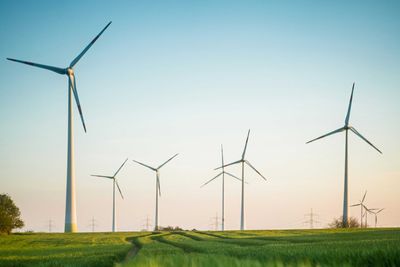
Texas continues to lead the nation in clean energy adoption and grid modernization. Photo by Moritz Lange on Unsplash
Texas leads the nation in energy production, providing about one-fourth of the country’s domestically produced primary energy. It is also the largest energy-consuming state, accounting for about one-seventh of the nation’s total energy use, and ranks sixth among the states in per capita energy consumption.
However, because Texas produces significantly more energy than it consumes, it stands as the nation’s largest net energy supplier. October marked National Energy Awareness Month, so this is an ideal time to reflect on how far Texas has come in improving energy efficiency.
Progress in Clean Energy and Grid Resilience
Texas continues to lead the nation in clean energy adoption and grid modernization, particularly in wind and solar power. With over 39,000 MW of wind capacity, Texas ranks first in the country in wind-powered electricity generation, now supplying more than 10% of the state’s total electricity.
This growth was significantly driven by the Renewable Portfolio Standard (RPS), which requires utility companies to produce new renewable energy in proportion to their market share. Initially, the RPS aimed to generate 10,000 MW of renewable energy capacity by 2025. Thanks to aggressive capacity building, this ambitious target was reached much earlier than anticipated.
Solar energy is also expanding rapidly, with Texas reaching 16 GW of solar capacity as of April 2024. The state has invested heavily in large-scale solar farms and supportive policies, contributing to a cleaner energy mix.
Texas is working to integrate both wind and solar to create a more resilient and cost-effective grid. Efforts to strengthen the grid also include regulatory changes, winterization mandates, and the deployment of renewable storage solutions.
While progress is evident, experts stress the need for continued improvements to ensure grid reliability during extreme weather events, when we can’t rely on the necessities for these types of energy sources to thrive. To put it simply, the sun doesn’t always shine, and the wind doesn’t always blow.
Federal Funding Boosts Energy Efficiency
In 2024, Texas received $22.4 million, the largest share of a $66 million federal award, from the U.S. Department of Energy’s Energy Efficiency Revolving Loan Fund Capitalization Grant Program.
The goal of this funding is to channel federal dollars into local communities to support energy-efficiency projects through state-based loans and grants. According to the DOE, these funds can be used by local businesses, homeowners, and public institutions for energy audits, upgrades, and retrofits that reduce energy consumption.
The award will help establish a new Texas-based revolving loan fund modeled after the state’s existing LoanSTAR program, which already supports cost-effective energy retrofits for public facilities and municipalities. According to the Texas Comptroller, as of 2023, the LoanSTAR program had awarded more than 337 loans totaling over $600 million.
In addition to expanding the revolving loan model, the state plans to use a portion of the DOE funds to offer free energy audit services to the public. The grant program is currently under development.
Building on this momentum, in early 2025, Texas secured an additional $689 million in federal funding to implement the Home Energy Performance-Based, Whole House (HOMES) rebate program and the Home Electrification and Application Rebate (HEAR) program.
This investment is more than five times the state’s usual energy efficiency spending. Texas’s eight private Transmission and Distribution Utilities typically spend about $110 million annually on such measures. The state will have multiple years to roll out both the revolving loan and rebate programs.
However, valuable federal tax incentives for energy-efficient home improvements are set to expire on December 31, 2025, including:
- The Energy Efficiency Home Improvement Credit allows homeowners to claim up to $3,200 per year in federal income tax credits, covering 30% of the cost of eligible upgrades, such as insulation, windows, doors, and high-efficiency heating and cooling systems.
- The Residential Clean Energy Credit provides a 30% income tax credit for the installation of qualifying clean energy systems, including rooftop solar panels, wind turbines, geothermal heat pumps, and battery storage systems.
As these incentives wind down, the urgency grows for Texas to build on the positive gains from the past several years despite reduced federal funding. The state has already made remarkable strides in clean energy production, grid modernization, and energy-efficiency investments, but the path forward requires a strategic and inclusive approach to energy planning. Through ongoing state-federal collaboration, community-driven initiatives, and forward-looking policy reforms, Texas can continue its progress, ensuring that future energy challenges are met with sustainable and resilient solutions.
---
Sam Luna is director at BKV Energy, where he oversees brand and go-to-market strategy, customer experience, marketing execution, and more.